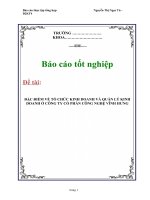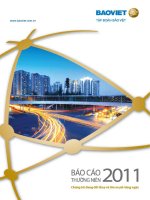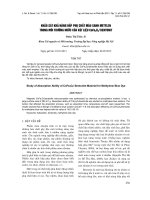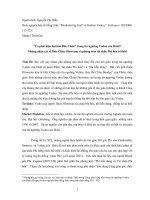Cong thuc chuyen doi cau thong dung trong tieng anh
Bạn đang xem bản rút gọn của tài liệu. Xem và tải ngay bản đầy đủ của tài liệu tại đây (507.05 KB, 12 trang )
REVIEW OF STRUCTURES – SENTENCE TRANSFORMATION
Model 1: Clause and phrases of reason:
Because
Because of
As
Due to
+ noun (phrase)/
Since
+ clause
As a result of
+ V-ing
Seeing that
On account of
Now that
Owing to
Model 2: clauses and Phrases of Concession:
Although
Despite
+ noun (phrase)/
Though
+ clause
In spite of
+ V-ing
Even though
Notwithstanding
Model 3: Phrases of result:
S + V + TOO + ADJ/ADV + (FOR sb) + TO_INF
S+ V+ NOT + ADJ/ ADV + ENOUGH + (FOR sb) + O_INF
E.g.:
Mary is too young to get married.
Mary is not old enough to get married.
The tea was not cool enough for her to drink.
The tea was too hot for her to drink.
Page
1
Model 4: Clauses and Phrases of Result:
S + V + TOO + ADJ/ADV + (FOR O) + TO-INF
S + V + SO + ADJ/ADV
+ THAT + S +V+
NOT….
S + V +SUCH + (A/An +ADJ) + N
E.g.:
The box was too heavy for the child to carry
The box was so heavy that the child could not carry.
It was such a heavy box that the child could not carry.
He spoke so quickly that I could not understand him.
He spoke too quickly for me to understand.
Model 5: Clauses and Phrases of Result:
S + V + ADJ/ADV + ENOUGH + (FOR O) + TO-INF
S + V + SO + ADJ/ADV
+ THAT + S +V….
S + V +SUCH + (A/An +ADJ) + N
E.g.:
This question is easy enough for us to answer.
This question is so easy that we can answer.
It is such an easy question that we can answer.
This song was so simple that she sing a.
It was such a simple song that she could sing.
Page
Model 6: clauses of result:
2
This song was simple enough for her to sing.
S + V + SO + ADJ/ADV + THAT + S _ V
S+ V + SUCH + (A/AN + ADJ) + N + THAT + S + V
The film was so good that I saw it 3 times.
It was such a good film that I saw it 3 times.
It is such a bad book that nobody reads it.
The book is so bad that nobody reads it.
Modal 7: TO-INF used as a subject:
TOO-INF … + BE + ADJ
IT + BE + ADJ + TO-INF
IT+ BE + ADJ + V-ING
HOW + ADJ + (IT +BE) + TO-INF
E.g.:
To listen to music all day is wonderful
It’s wonderful to listen to music all day
It’s wonderful listening to music all day.
How wonderful (it is) to listen to music all day.
Model 8: TO-INF used as a subject
TOO-INF … + BE + ADJ/N
To live on my salary must be hard.
Page
E.g.:
3
S + V + IT + ADJ/N + TO-INF …
I find it hard to live on my salary.
To be accurate is a good thing.
I think it a good thing to be accurate.
Notes: V: consider, find, think, hope, make
Model 9:
S + HAVE/HAS NOT + V-ED/V3 …. + TIME
IT IS + TIME …+ SINCE…. + V-ED/V2
My father hasn’t been to Hanoi for 2 years.
It is 2 years since my father was to Hanoi.
It is one month since I last saw my father.
I haven’t seen my father for one month.
Model 10:
S + HAVE/HAS NOT + V-ED/V3
…. +THE FIRST TIME + S + HAVE/HAS + VED/V3
I haven’t seen that man here before.
It’s the first time I have seen that man here.
It’s the first time I have read this book.
I haven’t read this book before.
Page
4
Model 11:
S + HAVE/HAS NOT + V-ED/V3 … SINCE/FOR…
THE LAST TIME + S + V-ED/V2…. + WAS …
I haven’t seen him since I was a student.
I last saw him when I was a student.
My father hasn’t been to Vung Tau for 2 years.
The last time my father was in Vung Tau was five years ago.
Model 12:
S + V-ED/V2 … AGO
S + HAVE/HAS + BEEN + V-ING = SINCE/FOR
He started working for this factory a year ago.
He has been working for this factory for a year/ since last year.
My sister has been studying English for 4 years.
My sister began studying English 4 years ago.
Model 13:
S + V +…+ TIME
IT + TAKE + (O) + TIME + TO-INF
She typed the letter in 20 minutes.
It took her 20 minutes to type the letter.
The flight to Hanoi lasted 3 hours.
Page
Model 14:
5
It took 3 hours to fly to Hanoi.
S + V + NOT +…+ UNTIL …
IT WAS NOT UNTIL … THAT S + V
Tom didn’t begin to read until he was 8.
It was not until Tom was eight that he began to read.
The doctor was not out until 2 o’clock.
It was not until 2 o’clock that the doctor was out.
Model 15: Causative form
S+V+O
S + HAVE/GET + O1 (S.O) + V0/ TO-INF + O2 (S.T)
S + HAVE/GET + O2 (S.T) + V0/ TO-INF + O1 (S.O)
Tom cleans the kitchen for us every day.
We have/get Tom clean/ to clean the kitchen every day.
We have/get the kitchen cleaned by Tom every day.
Model 16: Comparison of Adj/Adv
S + V + ADJ/ADV + ER
S + V + MORE + ADJ/ADV
+ THAN + S + (V)
S + V + THE + ADJ/ADV +EST
Page
6
S + V + THE MOST + ADJ/ADV
Have you got a cheaper hat than the others?
Is this the cheapest hat you have got?
Tom is the best football player in the team.
No one in the team is a better football player than Tom.
Model 17: Comparison of ADJ/ADV
S + V + NOT + SO/AS + ADJ/ADV + AS ..
S + V + ADJ/ADV + ER
+ THAN
MORE +ADJ/ADV
I don’t play the guitar as well as he does
He plays the guitar better than I do.
Stone isn’t as hard as iron.
Iron is harder than stone.
Model 18: Double Comparative
S + V, S + V
THE
+
THE
+
MORE ADJ/ADV
MORE
+ S + V, THE
+ S +V
ADJ/ADV + ER
LESS
MORE
MORE ADJ/ADV
+ S + V, THE
LESS
+ S +V
ADJ/ADV + ER
As he grows older, he becomes cheerful.
The older he grows, the more cheerful he becomes.
Page
The older I get, the less I want to travel.
7
As I get older, I want to travel less.
He eats much. He feel thirsty.
The more he eats, the thirstier he feels.
Model 19:
S + V + NOT, S + V + NOT … (EITHER)
NEITHER …. NOR…
He isn’t going to attend the meeting. I am not either.
Neither he nor I am going to attend the meeting.
My father doesn’t drink a lot. He doesn’t smoke a lot.
My father neither drinks nor smokes.
Model 20:
WHY DON’T YOU + V ….?
S + SUGGESTED THAT + S + SHOULD + V
‘Why don’t you apply for the job, Ann?’, said Sue
Sue suggested that Ann should apply for the job.
Model 21: Clause Phrase
S+
V-ED/V2
V-ING
DIDN’T + V
NOT + V-ING
HAD +V-ED/V3
HAVING + V-ED/V2
She opened the door and entered the room.
Opening the door she entered the room.
Tom had failed twice, so he didn’t want to try again.
Page
Not knowing the language , she found it hard to get work.
8
Because she didn’t know the language, she found it hard to get work.
Having failed twice, Tom didn’t want to try again.
Model 22:
S + CANNOT + V
S + PREVENT + O + FROM + V-ING
I couldn’t listen to the radio because of the noise.
The noise prevented me from listening to the radio.
Model 23:
CLAUSE
GERUND PHRASE
Let’s invite the Browns to the party on Sunday.
He suggested inviting the Browns to the party on Sunday.
She didn’t say a word as she left the room.
She left the room without saying a word.
We spent our childhood in that beautiful mountain resort and we always remember it.
We always remember spending our childhood in that beautiful mountain resort.
Model 24:
HARDLY/ SCARELY … WHEN
HARDLY/SCARELY/ONLY JUST …WHEN
NO SOONER …. THAN …
… NO SOONER … THAN
We had hardly/scarcely/hardly/scarely/only just seen me when/ when/ when/ than he ran away.
Hardly/ scarcely/ no sooner had he seen me when/when/than he ran away.
The performance had hardly begun when the lights went out.
Page
Model 25: Adjective <-> Verb
9
No sooner had the performance begun than the lights went out.
It is essential to finish the work today.
You don’t have to/ need to finish the work today.
Roses can’t grow/ be grown in such poor ground.
It is possible for roses to grow/ to be grown in such poor ground.
Model 26: Verb <-> Noun
He didn’t intend to stay there.
He had no intention of staying there.
He made a decision to leave home.
He decided to leave home.
Notes: Verb Noun
Visit
Pay a visit to SO/pay SO a visit
Know
Have knowledge of ST
Determine to
Determination
Make a success
Interest in
Take/ have interest in
Tend to
Have a tendency to do ST
Desire to
Have a desire to do ST
Think of
Give thought to
Look at
Have/ take a look at
bathe
Take/ have a bath
Help SO
Give help to SO
Hope
Have a hope of ST
Decide
Make a decision to do ST
Intend
Have an intention of V-ing/N
Page
Succeed in
10
do ST
Love SO
Be/ fall in love with SO
Start
Make a start
Rest
Take a rest
Agree
Be in agreement// reach/have/make an agreement
Argue
Have an argument
Sleep
Got a sleep
Talk
Have a talk
Change
Have a change of ST
Photograph
Take a photograph
Arrange
Make arrangements for ST/ for SO to do ST
Smile
Give a smile
Model 27: WISH
PRESENT
SENTENCE IN
PAST
SITUATION
FUTURE
V-ED/ V2/ WERE
S + WISH + S + HAD + V-ED/V3
WOULD + V2
What a pity you failed in your driving test.
Page
I wish my wife could speak French.
11
My wife can’t speak French.
I wish you hadn’t failed in your driving test.
She won’t visit me again.
I wish she would visit me again.
Model 28: Clauses and Phrases of purpose:
(NOT) TO-INF
S+V+
IN ORDER (NOT) TO –INF
SO AS (NOT) TO -INF
SO THAT
S+V+
CAN/ CAN’T
+S+
IN ORDER THAT
COULD/ COULDN’T
Model 29: not worth, no good and no point (not to be useful/ have no useful effects)
It’s (not) worth sth/ doing sth
It’s no good doing sth
There’s no point in doing sth
Page
12
It’s no use doing sth/ what’s the use (of doing sth)?









